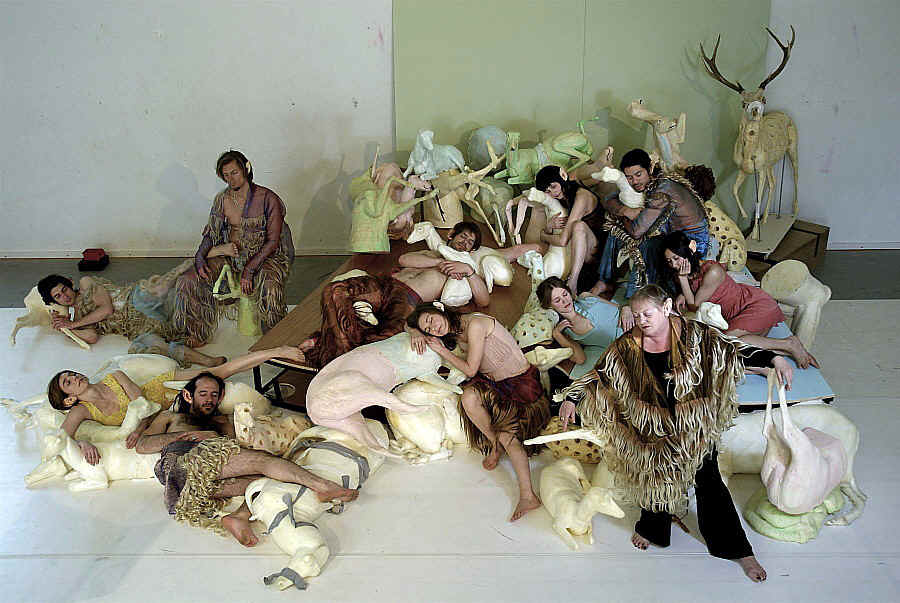|
The Deer House, the latest work by the Flemish theater troupe Needcompany, is an epic spectacle about chaos and beauty, theater and war. Of all European theatermakers, Needcompany’s director and playwright Jan Lauwers is virtually alone in remaining insistently aware that a brutal war is being fought somewhere on the planet, sometimes just a day’s trip by car from where he’s living. And in his work, he refuses to avert his gaze from that reality.
Like much of the company’s original work, The Deer House (at the BAM Next Wave Festival until October 9) was sparked by a very personal event. While on tour in France in 2001, company member Tijen Lawton received a phone call in the dressing room from her father with the news that her brother, a photojournalist, had been killed in Kosovo. Lauwers uses this incident as a jumping-off point to examine war not as a grim tragedy but, almost more horribly, as an everyday fact of life. He sets Part I of
The Deer House in the dressing room of a theater. Léo has just come back from identifying her brother’s body in Kosovo. (Originally, Lawton played this role herself; when that became too overwhelming emotionally, she was replaced by Eleonore Valere.) While she recounts her experience, the others actors come and go, undressing and putting on shredded animal costumes and elf ears, playing pranks, telling death stories, and doing silly/sexy dances. Sometimes there is quiet piano music, occasionally a burst of song. The actors call each other by their real names, no matter what roles they’re playing. They take turn reading excerpts from a diary that Léo found in her brother’s hotel room with detailed captions for a series of war photographs, going back and forth between English and French (surtitles provided).

This is Needcompany’s house style – the performance is not a straightforward play but a kind of collage, with several events happening simultaneously, competing for the audience’s attention, real and surreal morphing into one another, the stage picture constantly shifting. It has a richness and density reminiscent of the Wooster Group, whose director, Elizabeth LeCompte, is Lauwers’ biggest influence and inspiration. The tone of
The Deer House is dark but the palette is light – white underwear and towels, tan animal skins, creepy pale chunks of stuffed-toy deer carcasses that pile up all over the stage -- perhaps a reference to Milan Kundera’s
The Unbearable Lightness of Being, another Lauwers touchstone. Rehearsing in the dressing room, the actors pile onto a platform in a writhing “love sculpture” that suggests an open grave. The performers’ casual brutality with one another and their unnerving semi-nudity echo the stripping away of modesty and politeness that happens in a war zone.
In Part II, Lauwers and company attempt to imagine the story that led up to the photojournalist’s death. The action shifts from the dressing room to the deer house of the title on Christmas Eve, the family home of Kosovars who breed deer to sell their antlers. The photographer tells the family that, while taking pictures, he has been captured by soldiers and forced into a
Sophie’s Choice-type situation: he has to shoot a woman in front of her child, otherwise both will be killed. The mother has begged him to save her child, and so he has complied. He brought the child to a refugee camp and now he’s delivering the mother’s dead body to her family. They clumsily dress the naked corpse and fret about how to bury it in the winter when the ground is frozen and how to grieve in peace in a noisy household where one of the children is retarded and verbally unfiltered.
Story after story unfolds: stories of revenge, incest, manslaughter, kidnapping. Some of them sound like what-if actor improvisations, some have the echo of ancient fairytales. There are strange dances and little songs, recorded music that grows louder and more ominous, loud lamentations. People who are dead come back to life, or stay dead but sit up and talk. And the stories keep coming, until I found myself thinking: “Stop! Please stop with the endless stories! I can’t take any more!” And the essential power of the piece kicks in. Somehow in two intermissionless hours Needcompany has managed to conjure the relentlessness of war, which never stops for anybody’s convenience or discomfort. And the human impulse for storytelling becomes a valiant, desperate attempt to stave off death.
Finally, the end comes. It’s a relief and it’s wrenching at the same time. There’s a curtain call, everyone’s alive, all the props and the deer carcasses are piled on a platform upstage. Yes, they’re props, and yes, these are actors, and yet we also feel the weight of what they stand for, the uncounted corpses and the untold never-ending stories.
CultureVulture.net, October 7, 2010
|